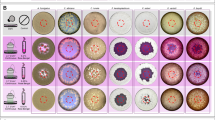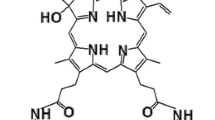Abstract
The pathogenic filamentous fungi Fusarium solani (F. solani) and Aspergillus fumigatus (A. fumigatus) are common causes of fungal keratitis. We have here evaluated the antifungal efficacy of photodynamic antimicrobial chemotherapy (PACT) with the novel chlorin derivative TONS 504 and a light-emitting diode (LED) with a wavelength of 660 nm for these fungal species. Isolated fungal spores were irradiated at LED energies of 10, 20, or 30 J/cm2 in the presence of TONS 504 at concentrations of 1 or 10 mg/L. As a control, spores were exposed to TONS 504 or LED radiation alone. The treated spores were then cultured on potato dextrose agar plates at 25 °C for 3 to 4 days before determination of colony formation as a measure of viability. Fungal growth was inhibited in a manner dependent on both LED energy and TONS 504 concentration. The inhibitory effect on F. solani was complete with TONS 504 at a concentration of 1 mg/L and LED irradiation at 30 J/cm2 as well as at a TONS 504 concentration of 10 mg/L and LED irradiation at 10, 20, or 30 J/cm2. In contrast, that on A. fumigatus was only partial at a TONS 504 concentration of 10 mg/L and LED irradiation at 20 or 30 J/cm2. The antifungal effect of PACT on A. fumigatus was thus inferior to that on F. solani. PACT with TONS 504 and an LED thus warrants further evaluation with regard to its potential effectiveness for the treatment of infectious fungal keratitis.



Similar content being viewed by others
References
Whitcher JP, Srinivasan M, Upadhyay MP (2001) Corneal blindness: a global perspective. Bull World Health Organ 79:214–221
Huang Z (2005) A review of progress in clinical photodynamic therapy. Technol Cancer Res Treat 4:283–293
Miller JW, Stinson WG, Gregory WA, el-Koumy HA, Puliafito CA (1991) Phthalocyanine photodynamic therapy of experimental iris neovascularization. Ophthalmology 98:1711–1719
Treatment of Age-Related Macular Degeneration with Photodynamic Therapy (TAP) Study Group (1999) Photodynamic therapy of subfoveal choroidal neovascularization in age-related macular degeneration with verteporfin: one-year results of 2 randomized clinical trials—TAP report. Arch Ophthalmol 117:1329–1345
Raab O (1900) Uber die Wirkung fluorescirender Stoffe auf Infusorien. Z Biol 19:525–546
Dougherty TJ, Lawrence G, Kaufman JH, Boyle D, Weishaupt KR, Goldfarb A (1979) Photoradiation in the treatment of recurrent breast carcinoma. J Natl Cancer Inst 62:231–237
Hayata Y, Kato H, Ono J, Matsushima Y, Hayashi N, Saito T, Kawate N (1982) Fluorescence fiberoptic bronchoscopy in the diagnosis of early stage lung cancer. Recent Results Cancer Res 82:121–130
Centers for Disease Control and Prevention (CDC) (1999) Four pediatric deaths from community-acquired methicillin-resistant Staphylococcus aureus–Minnesota and North Dakota, 1997–1999. MMWR 48:707–710
Leclercq R, Derlot E, Duval J, Courvalin P (1988) Plasmid-mediated resistance to vancomycin and teicoplanin in enterococcus faecium. N Engl J Med 319:157–161
Fagon JY, Chastre J, Domart Y, Trouillet JL, Gibert C (1996) Mortality due to ventilator-associated pneumonia or colonization with Pseudomonas or Acinetobacter species: assessment by quantitative culture of samples obtained by a protected specimen brush. Clin Infect Dis 23:538–542
Wilson M, Pratten J (1995) Lethal photosensitisation of Staphylococcus aureus in vitro: effect of growth phase, serum, and pre-irradiation time. Lasers Surg Med 16:272–276
Latief MA, Chikama T, Shibasaki M, Sasaki T, Ko JA, Kiuchi Y, Sakaguchi T, Obana A (2015) Antimicrobial action from a novel porphyrin derivative in photodynamic antimicrobial chemotherapy in vitro. Lasers Med Sci 30:383–387
Sueoka K, Chikama T, Latief MA, Ko JA, Kiuchi Y, Sakaguchi T, Obana A (2018) Time-dependent antimicrobial effect of photodynamic therapy with TONS 504 on Pseudomonas aeruginosa. Lasers Med Sci. https://doi.org/10.1007/s10103-018-2490-0
Latief MA, Chikama T, Ko JA, Kiuchi Y, Sakaguchi T, Obana A (2015) Inactivation of acyclovir-sensitive and -resistant strains of herpes simplex virus type 1 in vitro by photodynamic antimicrobial chemotherapy. Mol Vis 21:532–537
Hamblin MR, Hasan T (2004) Photodynamic therapy: a new antimicrobial approach to infectious disease? Photochem Photobiol Sci 3:436–450
Castano AP, Demidova TN, Hamblin MR (2004) Mechanisms in photodynamic therapy: part one–photosensitizers, photochemistry and cellular localization. Photodiagn Photodyn Ther 1:279–293
Maisch T, Baier J, Franz B, Maier M, Landthaler M, Szeimies RM, Bäumler W (2007) The role of singlet oxygen and oxygen concentration in photodynamic inactivation of bacteria. Proc Natl Acad Sci U S A 104:7223–7228
Nitzan Y, Dror R, Ladan H, Malik Z, Kimel S, Gottfried V (1995) Structure-activity relationship of porphines for photoinactivation of bacteria. Photochem Photobiol 62:342–347
Minnock A, Vernon DI, Schofield J, Griffiths J, Parish JH, Brown ST (1996) Photoinactivation of bacteria. Use of a cationic water-soluble zinc phthalocyanine to photoinactivate both gram-negative and gram-positive bacteria. J Photochem Photobiol B 32:159–164
Aguirre J, Ríos-Momberg M, Hewitt D, Hansberg W (2005) Reactive oxygen species and development in microbial eukaryotes. Trends Microbiol 13:111–118
Ikner A, Shiozaki K (2005) Yeast signaling pathways in the oxidative stress response. Mutat Res 569:13–27
Temple MD, Perrone GG, Dawes IW (2005) Complex cellular responses to reactive oxygen species. Trends Cell Biol 15:319–326
Toledano MB, Delaunay A, Monceau L, Tacnet F (2004) Microbial H2O2 sensors as archetypical redox signaling modules. Trends Biochem Sci 29:351–357
Nakagawa Y, Koide K, Watanabe K, Morita Y, Mizuguchi I, Akashi T (1999) The expression of the pathogenic yeast Candida albicans catalase gene in response to hydrogen peroxide. Microbiol Immunol 43:645–651
Wysong DR, Christin L, Sugar AM, Robbins PW, Diamond RD (1998) Cloning and sequencing of a Candida albicans catalase gene and effects of disruption of this gene. Infect Immun 66:1953–1961
Calera JA, Paris S, Monod M, Hamilton AJ, Debeaupuis JP, Diaquin M, López-Medrano R, Leal F, Latgé JP (1997) Cloning and disruption of the antigenic catalase gene of aspergillus fumigatus. Infect Immun 65:4718–4724
Paris S, Wysong D, Debeaupuis JP, Shibuya K, Philippe B, Diamond RD, Latgé JP (2003) Catalases of aspergillus fumigatus. Infect Immun 71:3551–3562
Perlin DS, Shor E, Zhao Y (2015) Update on antifungal drug resistance. Curr Clin Microbiol Rep 2:84–95
Sanglard D (2016) Emerging threats in antifungal-resistant fungal pathogens. Front Med (Lausanne) 3:11
Acknowledgements
We thank Isao Sakata (Porphyrin Laboratory, Okayama, Japan) for providing information on TONS 504, and Akira Ichikawa (CCS, Kyoto, Japan) for building the LED device according to our design.
Funding
This work was supported by the Japan Society for the Promotion of Science (JSPS) KAKENHI Grants-in-Aid for Scientific Research (C) (nos. 15K10894 and 18K09411).
Author information
Authors and Affiliations
Corresponding author
Ethics declarations
Conflict of interest
The authors declare that they have no conflict of interest.
Ethical approval
This article does not contain any studies with human participants or animals.
Rights and permissions
About this article
Cite this article
Sueoka, K., Chikama, T., Pertiwi, Y.D. et al. Antifungal efficacy of photodynamic therapy with TONS 504 for pathogenic filamentous fungi. Lasers Med Sci 34, 743–747 (2019). https://doi.org/10.1007/s10103-018-2654-y
Received:
Accepted:
Published:
Issue Date:
DOI: https://doi.org/10.1007/s10103-018-2654-y




